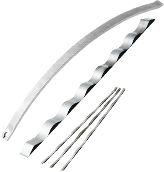- keyword
- compressionsprings
- grinding
- springindex
Question K K 2007/1/9(Tue) 17:35
Generally, it is said that if the wire diameter is 0.5 mm or less, and even if it exceeds 0.5 mm, the spring index D/d is unnecessary.
How should this be understood in a real application?
Please tell me the point from which we need to consider the spring index. (Of course, I think it depends on the conditions, but a rough number is fine). Thank you.
Answer Tokai Spring 2007/1/10(Wed) 14:53
Thank you for writing to us, K K!
We do not grind wires with diameters of less than 0.5 mm, but we do grind wires with diameters of 0.5 mm or more. There is no particular standard for D/d (coil mean diameter/wire diameter) in end coils’ surface grinding, but if D/d is 22 or more, it is necessary to check in JIS B2704 whether grinding can be performed or not.
Answer K K 2007/1/13(Sat) 13:15
Thank you for your reply. I have another question.
I think that the primary purpose of grinding the surface of the end coils is to prevent the spring from tilting and to apply the load in the direction perpendicular to the coils, but if the tilt is prevented by restraining the spring with a metal core, etc., I think I will not grind the end coils.
Is there a concentration of stress on the end coil parts? I think that there will be no problem if the stress concentration does not reach the weakest part of the spring, but please tell me the effect on the spring strength if I do so.
Answer Tokai Spring 2007/1/19(Fri) 18:28
The concentration of stress on the end coil parts seems to be less problematic.
In many cases, breakage etc. is due to the concentration of torsional stress on the active coils.
We are happy to answer any inquiries regarding technology, specifications, materials, etc. Please feel free to ask.

















